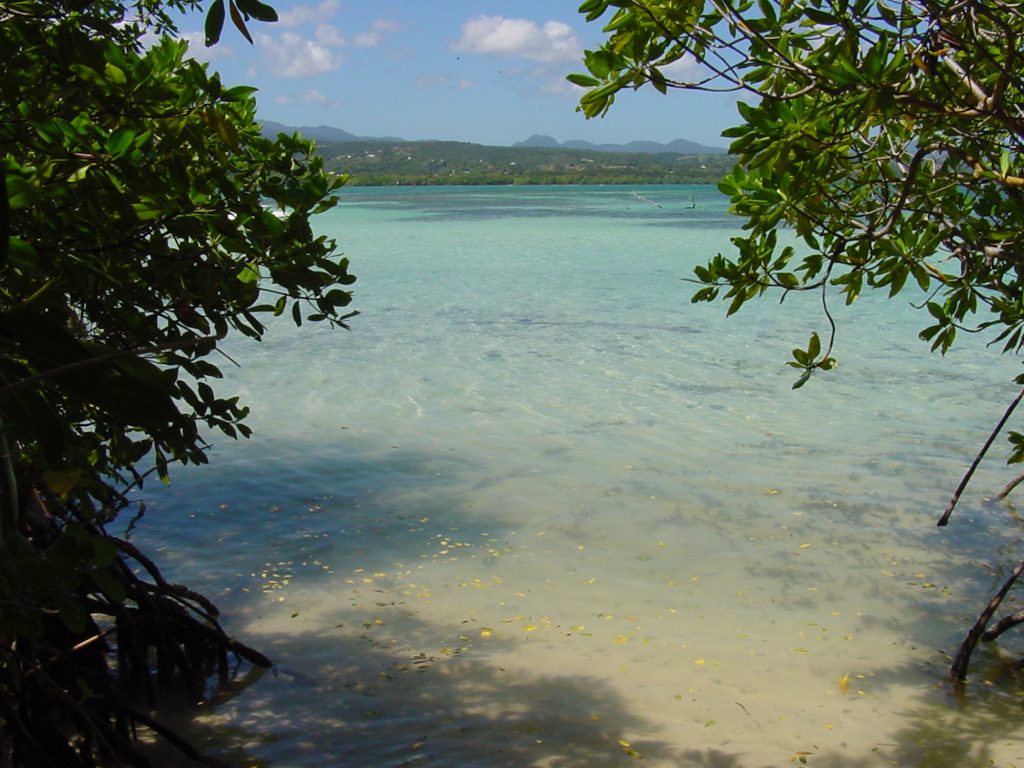
Little Marine Bay (Petit Cul-de-sac Marin)
Description
At the confluence of Basse-Terre and Grande-Terre, the Petit Cul-de-sac Marin is connected to the Grand Cul-de-sac Marin by the Rivière Salée. From the islet of Gosier in the south of Grande-Terre to Petit-bourg in the northeast of Basse-Terre, this area is very rich biologically and covers 5,340 ha. Highly urbanized due to the installation of the economic zone of Jarry, the urban area of Pointoise and the Autonomous Port of Guadeloupe, it still has a natural reserve with mangroves, islets and the green valley, including Pointe à Bacchus.
This cul-de-sac, like the Grand Cul-de-sac Marin, is important for the prevention of natural hazards and serves as a transition strip between land and sea. In addition, its waters linked to the Rivière Salée and its mangroves are the habitat of a varied and very fragile fauna.
ged* in 2015 to accommodate larger container ships, this ecosystem continues to be damaged. Fortunately, the relatively untouched îlet Cochon (the largest in the area) and Pointe à Bacchus, a lush garden, offset the sadder side of the place. This orchard, which has always housed crops, shows us along with the study of the diet of the Kalinas* that the Creole orchard* is an extension of the crops of the Amerindians.
Biodiversity
North of Petit-Bourg, Pointe à Bacchus, which receives the trade winds and is protected from the oceans, is green. Overlooking the Caribbean Sea, it has a rich diversity of environments. This place meets sugarcane fields, hedgerows, mangroves and swamp forests*
Like an ecomuseum*, many species were cultivated there long before the arrival of the settlers: pineapples (Ananas comosus), cashews (Anacardium occidentale), guavas (Psidium guajava), papayas (Carica papaya L.) and apricots (Prunus armeniaca), cassava or manioc (Manihot esculenta), sweet potatoes (Ipomoea batatas) and other roots and tubers, prickly pears (Opuntia sp.), raquettes bord de mer, custard apple or bullock’s heart (Annona reticulata) and numerous medicinal plants*. Sand fiddler crabs (Uca pugilator) reside in the mangroves and swamp forests, but also birds such as the mangrove cuckoo (Coccyzus minor).
Ecotourism potential
Hilly landscape with a great diversity of environments, it is possible to enjoy a beautiful walk of two hours in the Garden of the Pointe à Bacchus. Open and well signposted, it attracts nature lovers and curious people. Fully owned by the Conservatoire du Littoral, Pointe Bacchus benefits from true protection and enhancement of its biotopes.
The turquoise waters of the Petit cul-de-sac marin invite visitors to discover the islets that surround it. It is possible to enjoy a good picnic in the open sea, but it is important to be careful not to feed the aquatic fauna or trample the seagrass beds.
Informations
-
-
Location
